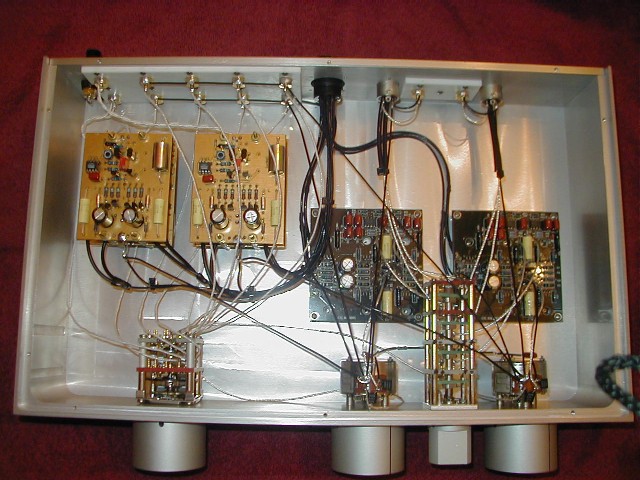Well, everyone, some people make successful audio products that seem to sell better than some others, and I suspect because they concern themselves with any potential problem, large or small. In power supplies, I would not, at first, suspect that fuses would be a great problem, but I know of hi fi modifiers who REMOVE fuses and get better sound, so maybe, higher quality fuses might be a better solution.
We addressed this problem with the BLOWTORCH by using solid state slow blow fuses that we auditioned before we used them. Their advantage is that they are HARD WIRED into the input of every transformer, removing all the rest of the 'built for economy' connections typical in a fuse holder. We have also used circuit breakers to replace input fuses on some models of Parasound. A real improvement, but then I do hear differences between amplifiers, even of my own design. What a concept! '-)
In other words, you can't provide any more enlightenment than "I put some photographs of myself in my freezer and my system sounded better."
se
It is interesting, with all the advertising in the western world today, how hi end could 'capture' customers with 'an experience' rather than better sound than average. For example, an automobile manufacturer might have to work to build a better car, to get and keep customers coming back, rather than just an 'experience'. Better cars invariably cost more money to design and reproduce, and therefore they are more expensive, at least with everything else being equal. It is the same in hi end audio.
It is interesting, with all the advertising in the western world today, how hi end could 'capture' customers with 'an experience' rather than better sound than average. For example, an automobile manufacturer might have to work to build a better car, to get and keep customers coming back, rather than just an 'experience'. Better cars invariably cost more money to design and reproduce, and therefore they are more expensive, at least with everything else being equal. It is the same in hi end audio.
The car/audio analogies become tiresome (so to speak). No need to focus on the male fetish object aspect of things.
In other words, you can't provide any more enlightenment than "I put some photographs of myself in my freezer and my system sounded better."
se
Pretty funny, but let's not get too carried away..

The car/audio analogies become tiresome (so to speak). No need to focus on the male fetish object aspect of things.
I've always wondered why it is that most women are not too interested in our hobbies..
Probably no need to answer, my wife can tell me, heck I already know..
I don't think of cars as a 'fetish' object, but as an 'engineering' object. I have always been fascinated with autos, how they work, how to improve them, and what brands are the best. My interest in them came before electronics, and before cars, it was horses. Is there something wrong with this? Did most of you get to own and work on your own cars, rebuild engines when necessary, and improve them when you could? Rebuilding an engine and getting it to run again was just as satisfying as making an electronic project and getting it to work. When I was young, guys worked on cars, even their girl friends', women made the home comfortable. There was a separation in responsibilities at the time, but everybody seemed to do OK. What do they do today?
a solid block of machined aluminum is such a brilliant idea, it is a vehicle to sell a piece of no holds barred electronics that otherwise might not have found its way to the market.
To name a few ;
- Ayre
- Boulder
- Goldmund
- Jeff Rowland
- Orpheus
(more from e.g. Japan and France if it's not enough)
Attachments
...AND it is less mechanically resonant.
Is it?
Bet if I hung it from a string and struck it it'd ring like a bell.
se
Hi,
It seems you could use quite a few lessons in many areas.
BTW, non-linear effects in Fuses are well documented. The ones in series with drivers etc. show very measurable levels of distortion, quite possibly audible. Rail fuses can also increase measured HD appreciably.
Mains fuses, hard to say. However I do not presume to tell others what they can hear or not or insist that they must use generic fuses if they would prefer them gold plated and with fusible silver wire link instead.
You don't have to use them, or buy an AMP Phonostage or Amplifier or CD-Player etc.
Remember, you already have the best gear in the world, absolute perfection, completely incapable of being improved... So you don't need mine.
Ciao T
No need for a marketing lesson from you Torsten.
It seems you could use quite a few lessons in many areas.
BTW, non-linear effects in Fuses are well documented. The ones in series with drivers etc. show very measurable levels of distortion, quite possibly audible. Rail fuses can also increase measured HD appreciably.
Mains fuses, hard to say. However I do not presume to tell others what they can hear or not or insist that they must use generic fuses if they would prefer them gold plated and with fusible silver wire link instead.
You don't have to use them, or buy an AMP Phonostage or Amplifier or CD-Player etc.
Remember, you already have the best gear in the world, absolute perfection, completely incapable of being improved... So you don't need mine.
Ciao T
Is it?
Bet if I hung it from a string and struck it it'd ring like a bell.
se
But it's not hung by a string, is it? It's sitting on nice damping feet on a solid shelf and lots of mass should make it less vulnerable to sound vibration than flimsier enclosures.
I don't know why you get cranked by John or Thorsten designing luxury goods. There's no demand for anything until it's produced. They take their chances in the market and there's always a possibility of failure. And if you're in the luxury market, then you can't charge small change, even if that's what your costs are, cuz luxury buyers won't buy cheap. (They'll buy distressed, but the original price has to be high).
But it's not hung by a string, is it? It's sitting on nice damping feet on a solid shelf and lots of mass should make it less vulnerable to sound vibration than flimsier enclosures.
If the thinner enclosure is sitting on the same shelf with the same feet, how is it any more vulnerable to vibration?
Also, what John stated the chassis itself was less resonant. How is it less resonant?
I don't know why you get cranked by John or Thorsten designing luxury goods.
Where have I said anything about anyone designing luxury goods?
John said the thicker chassis was less resonant. I'm simply asking him how exactly it's less resonant than a thinner chassis. What's that have to do with luxury goods?
se
When I go to a manufacturers trade show I see a lot of metal cases. Some cast, some hogged, some made in other ways. We have looked high and low for a CHEAPER way to make a case with the same qualities, ie ruggedness, finish-able, and finally passing the FINGERNAIL TEST. Just take your fingernail and click it against the side of a candidate. This will tell you whether it is high Q, or well damped. Try it on your equipment at home.
When I go to a manufacturers trade show I see a lot of metal cases. Some cast, some hogged, some made in other ways. We have looked high and low for a CHEAPER way to make a case with the same qualities, ie ruggedness, finish-able, and finally passing the FINGERNAIL TEST. Just take your fingernail and click it against the side of a candidate. This will tell you whether it is high Q, or well damped. Try it on your equipment at home.
Well damped? Where's the damping material? I don't recall seeing any inside the chassis.

Again, hang it by a string and strike it. It'll ring like a bell.
se
Last edited:
It is interesting to see the input of one of my preamps. I have never opened my own, but it would look almost exactly like this picture. You are looking at it upside down. The Vendetta boards are on the left, with Teflon Eq caps. The line amp boards are on the middle right are are made of Teflon. Each module has its own dual DC regulator or cap multiplier. DC only comes in from the middle back connector that has multi-pins. There are four separate regulators in another almost identical box that convert AC to dc for each gain block. All of the wiring is pure silver that we used to be able to buy at a significant price to us. Unfortunately, it is unavailable at this time. I wish that I would have stocked up.
Last edited:
A little more: the yellow caps are Rel RT polystyrene caps. They are very well 'damped' just like the case. The electrolytic caps are Nichicon Muse, non-magnetic leaded caps. The red caps are Panasonic and used only for the servos. (lots of servos)
The big switch is to reverse the polarity of the output.
The volume pots are TKD, a rather expensive pot that costs us almost $200 ea. However it is better than making them ourselves, at least from our point of view. '-)
The big switch is to reverse the polarity of the output.
The volume pots are TKD, a rather expensive pot that costs us almost $200 ea. However it is better than making them ourselves, at least from our point of view. '-)
- Status
- Not open for further replies.
- Home
- Member Areas
- The Lounge
- John Curl's Blowtorch preamplifier part II
